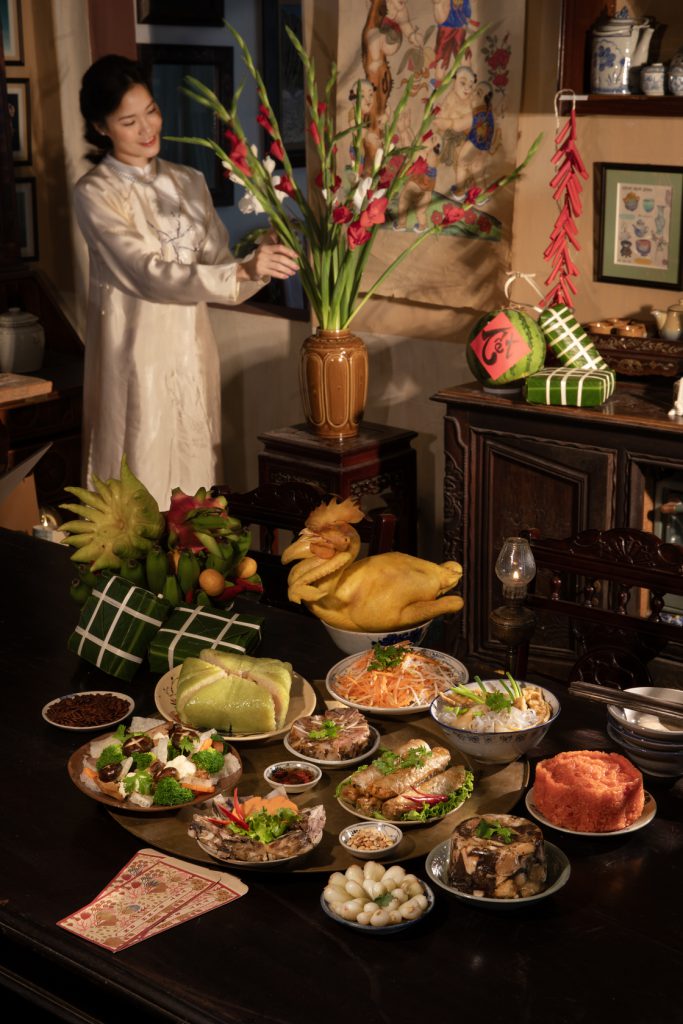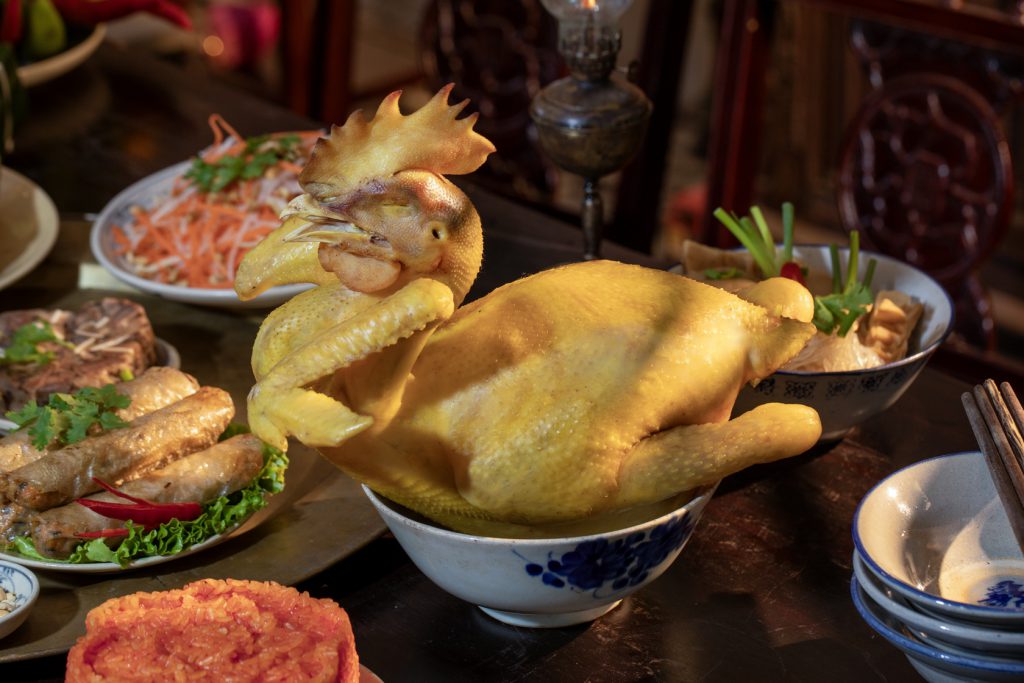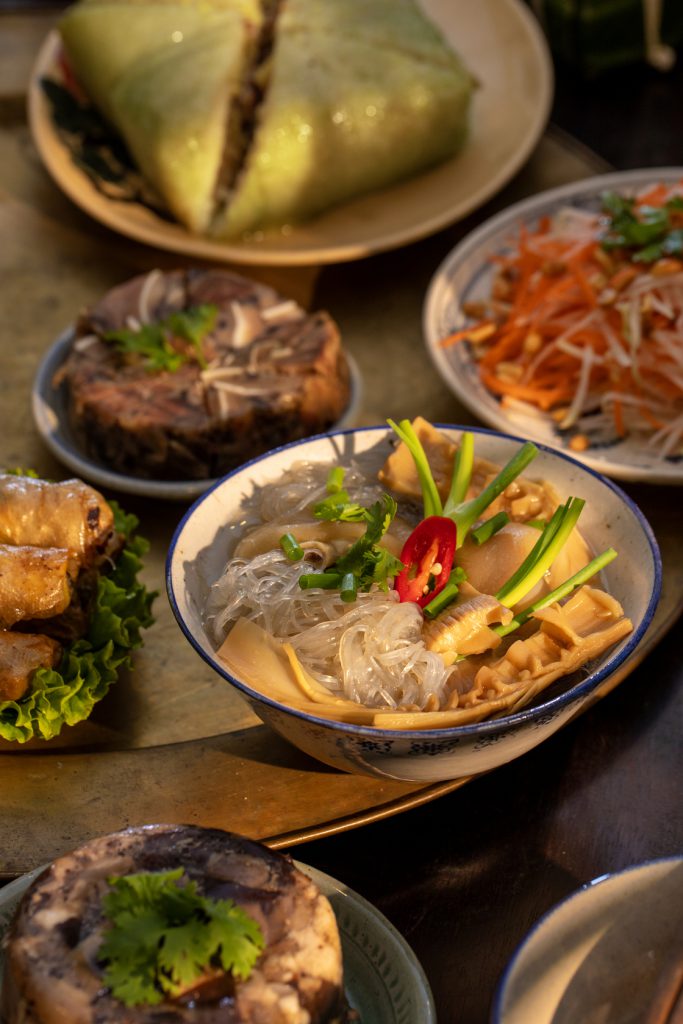Story: Tu Anh
Photos: Vu Minh Quan
Each spring, the Tet holiday feast reminds us of family reunions. Join Heritage in exploring the flavors of Tet through traditional Northern Vietnamese dishes.

Banh chung
Chung cakes are a key traditional delicacy during the Tet holidays. The cake’s crust is made from sticky, fragrant glutinous rice. The filling typically includes pork, mung beans, and black pepper. Formed into a square shape and wrapped in dong leaves, the cake is boiled for 14 hours, then rinsed with clean water and pressed to drain. A well-made Chung cake tastes of soft rice, rich fatty pork, warm and fragrant mung beans, and warming pepper.
Red sticky rice
Red is the color of luck and happiness. Therefore, a Tet menu is incomplete without a plate of red sticky rice. This dish is made from high-quality sticky rice mixed with mashed spiny bitter cucumber blended with glutinous rice wine. The mix is steamed until the rice turns a beautiful shade of bright red.
Vietnamese head cheese
Vietnamese head cheese is made from the meat of a pig’s head and ears, chopped and mixed with finely diced wood ear mushrooms, fish sauce, and black pepper. After being sautéed, the meat mixture is wrapped in banana leaves, tightly tied with bamboo strings, and boiled or steamed. When served, the head cheese is sliced into triangular pieces that can be neatly arranged and easily picked up.
Boiled chicken
Boiled chicken is a simple yet indispensable dish for Tet. Chunks of golden-yellow chicken sprinkled with finely chopped lime leaves and dipped in a mixture of salt, pepper, lemon, and chili create an unforgettable flavor.

Fried spring rolls
The filling for spring rolls typically includes finely chopped pork shoulder, glass noodles, shiitake mushrooms, wood ear mushrooms, fresh onions, kohlrabi, carrots, eggs, pepper, and fish sauce. The filling is wrapped in a type of rice paper to form long thin rolls. The spring rolls are tastiest when fried to a golden brown in lard. The dipping sauce must balance the saltiness of the fish sauce, the sourness of lemon juice, and the sweetness of added sugar. The dip also contains a bit of minced garlic, a few slices of fresh chili, and aromatic pepper.
Aspic (meat jelly)
Traditional aspic is made from pork hock, pig’s ears, shiitake mushrooms, and wood ear mushrooms. In the cold weather of early spring, there’s nothing more delightful than enjoying aspic with pickled onions, a true Northern Tet delicacy.

Mixed stir-fried dried pig skin
Ingredients usually include heart, kidney, or pork loin, plus peas, green onions, celery, green and white cauliflower, shiitake mushrooms and—of course, dried pig skin. The ingredients are mixed and stir-fried to create a visually appealing dish full of vibrant colors. The chewy dried pig skin absorbs the sweet flavors of the organ meat.
Dried bamboo shoots and glass noodle soup
Among traditional soups, a bowl of glass noodle soup with dried bamboo shoots and either pork trotters or ribs is essential. The pork trotters or ribs are cut into bite-sized pieces and sautéed until fragrant, then simmered on low heat. The bamboo shoots are soaked and boiled several times, then stir-fried with dried onions and spices. When arranging the feast, glass noodles are blanched and added to a bowl, then topped with pork trotters, bamboo shoots, and green onions. A sprinkle of fresh coriander adds to the dish’s appeal.

Kohlrabi and carrot salad
This salad helps to cut through the greasiness of a protein-rich feast. It consists of julienned kohlrabi (German turnip) and carrots, mixed with aromatic herbs and crushed peanuts. The dressing is made from fish sauce, sugar, lemon juice or vinegar, pepper, and chili, adjusted to taste. This salad is a simple but popular side dish.
A Tet holiday feast is initially prepared to offer to the gods and ancestors. Later, the food serves as a focal point when the family gathers, symbolizing the blessings of the gods and ancestors, with the hope that all family members will be blessed with health and abundant happiness.










